September 2, 2016
Funny Marketing
Something about writing for the Internet provokes a subtle shift in people. You’re perfectly normal in person. But the moment you have to write a blog or an article, you turn into PersonBot3000. You get mechanical. You lose your sense of humor. And your readers lose interest. One potential solution? Humor. If you’re trying to find a brand voice that doesn’t get lost in the mausoleum of boring-ass corporate voices, a joke or two might be just what the CryptKeeper ordered. Old Spice, Dollar Shave Club, and other brands that have nothing to do with men’s grooming have showed us for years that humor can be a fabulous tactic for grabbing interest and building goodwill.
The most-referenced example of funny marketing ever: Old Spice
The first Old Spice Man video by Wieden + Kennedy has gotten more than 53 million views on YouTube since its February 2010 release.
Overall, the wildly popular “Smell Like a Man, Man” campaign boosted traffic to oldspice.com by 300%, and shot the brand to #1 in both deodorant and body wash sales, according to P&G.
A less-referenced, but still awesome example: Cultivated Wit
Cultivated Wit, whom I’d love to work with if they’re reading this (hiii!), has built its whole brand around humor. Their motto? “We Make Fun”. Check out one of the best emails I’ve ever gotten from them: 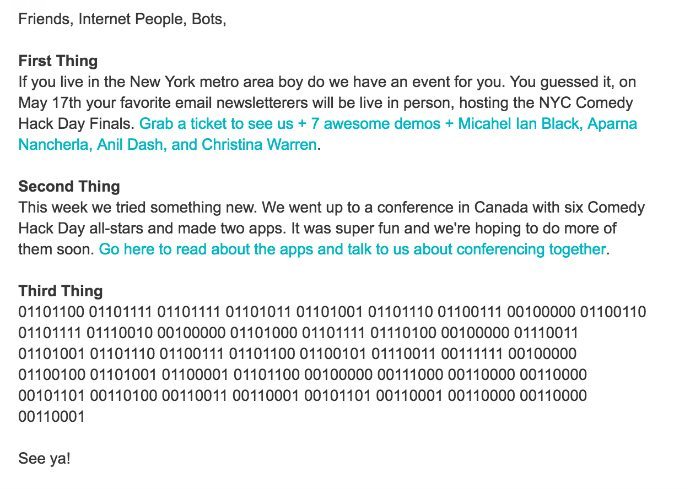 Even the footer of Cultivated Wit’s homepage is snort-inducing.
Even the footer of Cultivated Wit’s homepage is snort-inducing.  They also host Comedy Hack Day, which, I mean…just click on it. OK, great. Let us give thanks for funny marketing. It’s what gets most of us through the Super Bowl every year. But if you don’t have thousands of dollars or access to the brightest minds in comedy to throw at your marketing, how can you use humor to its best effect? By “best effect,” I mean: 1) avoid offending (too many) people, 2) spark and maintain interest in your brand or product, and 3) make sure your message sticks in your audience’s minds. Ready, get set, turn up your nose–’cause we’re gonna dive into the marketing literature.
They also host Comedy Hack Day, which, I mean…just click on it. OK, great. Let us give thanks for funny marketing. It’s what gets most of us through the Super Bowl every year. But if you don’t have thousands of dollars or access to the brightest minds in comedy to throw at your marketing, how can you use humor to its best effect? By “best effect,” I mean: 1) avoid offending (too many) people, 2) spark and maintain interest in your brand or product, and 3) make sure your message sticks in your audience’s minds. Ready, get set, turn up your nose–’cause we’re gonna dive into the marketing literature.
Funny marketing is old news. And that’s good news for you.
First things first: You are not alone. Humor in advertising and marketing is an “important part of everyday life,” according to Martin Eisend, who performed a meta-analysis of studies of humor in advertising in 2009. And marketers have been studying the effects of being funny on advertising comprehension since at least 1984. Why is this pile of scholarly articles good news? It means you can research what’s been done before, what worked, and in some cases, why it worked. 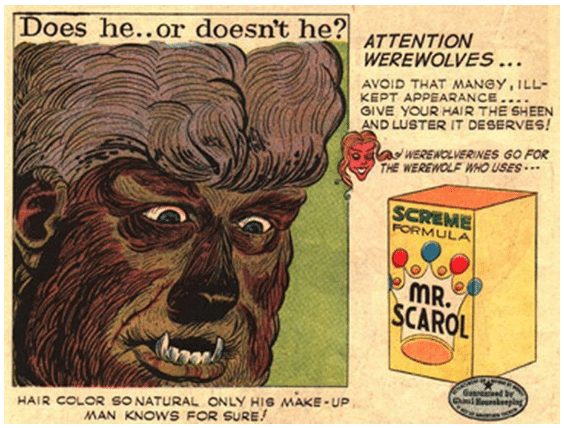 This used to be considered funny. Glad we’ve progressed since then: in marketing, women’s rights, racial equality, hair-growth products…hmmm, wait… While a clever tagline or a weird illustration used to be enough to catch a target prospect’s eye, these days, marketers have to do more. The Internet is saturated with advertising, so any brand worth its salt* is focusing on making its online marketing ploys stand out. I can’t tell you how to be funny (even though there are 78 million Google results for that search query), or what humor approach will work best for your brand. But I can tell you how humor works in the brain–and when not to go for the joke. *****Minus Morton Salt, apparently. The closest they get to humor is using the Abominable Snowman and some kawaii penguins to shill their ice-melting products.
This used to be considered funny. Glad we’ve progressed since then: in marketing, women’s rights, racial equality, hair-growth products…hmmm, wait… While a clever tagline or a weird illustration used to be enough to catch a target prospect’s eye, these days, marketers have to do more. The Internet is saturated with advertising, so any brand worth its salt* is focusing on making its online marketing ploys stand out. I can’t tell you how to be funny (even though there are 78 million Google results for that search query), or what humor approach will work best for your brand. But I can tell you how humor works in the brain–and when not to go for the joke. *****Minus Morton Salt, apparently. The closest they get to humor is using the Abominable Snowman and some kawaii penguins to shill their ice-melting products.
How humor works in the brain
Multiple different areas of the brain work together to help you process and appreciate jokes, from regions involved in language processing to the prefrontal cortex, which is related to the brain’s reward system. When the brain “gets” a joke, one or more of those areas lights up like a Christmas tree. This reaction is akin to what happens when the brain solves a problem, according to neuroscientist Scott Weems and others. In other words, getting a joke feels like getting a treat. And it makes us want more. Unless you’re a zombie with an interest in marketing, you’re probably not thinking too closely about targeting specific parts of your audience’s brains. But it’s still important to consider what type of humor will best represent your brand and hit home with your audience. Humor comes in lots of flavors: self-deprecating, critical, absurd, aggressive, or “obvious truth” with new spin. Author Rod A. Martin offers an overview of the types in The Psychology of Humor: An Integrative Approach. Absurdity plays a big role in contemporary marketing, hence the popularity of The Man Your Man Could Smell Like, and Terry Crews’ jarringly loud, later take on the Old Spice persona.
I never knew I needed to try this Old Spice scent until Terry yelled it at me. Another approach? Incongruity. Creating a mismatch between expectations and reality cracks people up. Researchers handily illustrated this concept when they asked people to lift heavy-looking weights that were actually made of Styrofoam…and those people smiled or laughed. IKEA’s recent “Let’s Relax” video is a great example of incongruity.
The whole time, you’re thinking, “WTF does this baroque family meal have to do with IKEA?” and then, finally, the brand makes a soft entrance at the end, in the form of a warm, comfortably furnished kitchen. Haaa. Whatever you do, choose a type of humor that doesn’t distract from your marketing goals. Humor should ultimately serve your bottom line. Producing one-off funny videos unrelated to your business might take you into the nebulous territory of “brand-building,” into which so many marketing departments disappear, never to be seen again.

Brand-building via red herrings is great when you have a deep marketing strategy and deeper pockets…and not so great when you’re crossing your fingers and hoping that that wacky video you made will produce genuine, long-lasting affection for your brand. If you can’t connect being funny with making money, do not pass go. Do not collect $200. Do not waste your time. But maybe try it first, because…
Humor is naturally viral
Like the flu, a good joke is naturally viral. Unlike the flu, you’ll enjoy getting it. In a 2013 study of Generation Y (meaning everyone you know, minus your parents and their parents), videos related to the concepts “funny” and “laugh” were also highly related to the concepts of “friends” and “send” (Botha and Reyneke 2013). Multiple social media studies have also shown that posts which tend to get the most shares are those that inspire positive feelings. Essentially, happiness is more shareable than sadness. This is why the mysterious Facebook algorithm seems to show your posts about success, excitement, and big news to more of your friends than your “I’m eating Sun Chips in my underpants and I am very, very sad” posts.
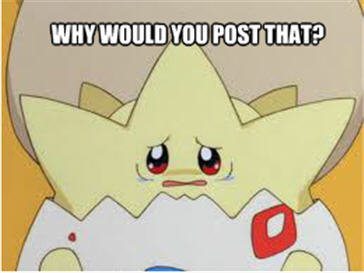 Sad Togepi does not know how to help you. Also, he will not share your post.
Sad Togepi does not know how to help you. Also, he will not share your post.
Basically, if you found something funny and you thought it’d make your friends laugh, you’d pass it along. If you found something sad, you probably wouldn’t try to make all your friends sad by sharing it. Would you, you sociopath?
Pull it off: A few soft and slow rules for funny marketing
Want to crack a few jokes? Get started with these decidedly not-hard-and-fast rules.
Rule #1: Do your research
As in standup comedy, timing and context are everything when it comes to humor in marketing. We all remember when DiGiorno used the anti-domestic violence hashtag #WhyIStayed to promote its pizza. Whoever was tweeting on behalf of the brand didn’t look at the hashtag’s context before tweeting. 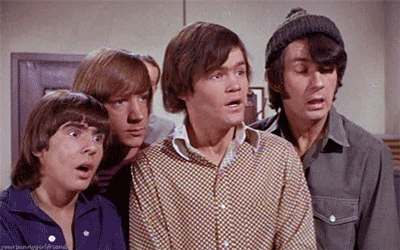 I cringed so hard, I’m still pulling my toes out of my neck. BAD MOVE, DIGIORNO. (Though, to the brand’s credit, the Guilty Tweeter personally apologized to everyone who objected.)
I cringed so hard, I’m still pulling my toes out of my neck. BAD MOVE, DIGIORNO. (Though, to the brand’s credit, the Guilty Tweeter personally apologized to everyone who objected.)
Rule #2: Be matchy-matchy
If you’re going to take a stab at funny, make sure you’re stabbing all over. Wait, let me rephrase that… Your brand voice should be unified. Don’t create a hilarious online presence, and act super-dry on the phone with your prospects. Don’t make awesome videos, then send emails so boring your subscribers wonder if you’ve been in a bad accident. An inconsistent brand voice confuses people. And confusion is bad for conversion. What a letdown it was to laugh at digital agency R/GA on Twitter, then get to their site’s about page and meet an aspirational blurb about connection in the digital age.  Yassss, let me check out their Contact Us page to see what other snark-filled delights await me! Oh, um….
Yassss, let me check out their Contact Us page to see what other snark-filled delights await me! Oh, um…. 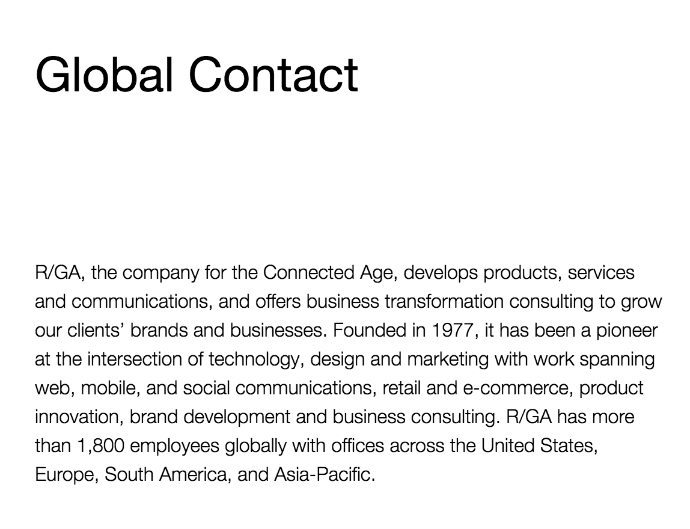 Never mind, I’ll just stick to Twitter… sad trombone
Never mind, I’ll just stick to Twitter… sad trombone
Rule #3: Do you, boo
I promise this is not going to turn into another post about “being authentic” or “being your genuine self”. Mostly because this is the end of the post. (You did it!) But also because sometimes, brands take shortcuts to earning goodwill and dollars by imitating someone else’s funny work. And that’s not cool. Here’s Skittles adding muscular arms to their product…which just makes them look kinda like Old Spice. 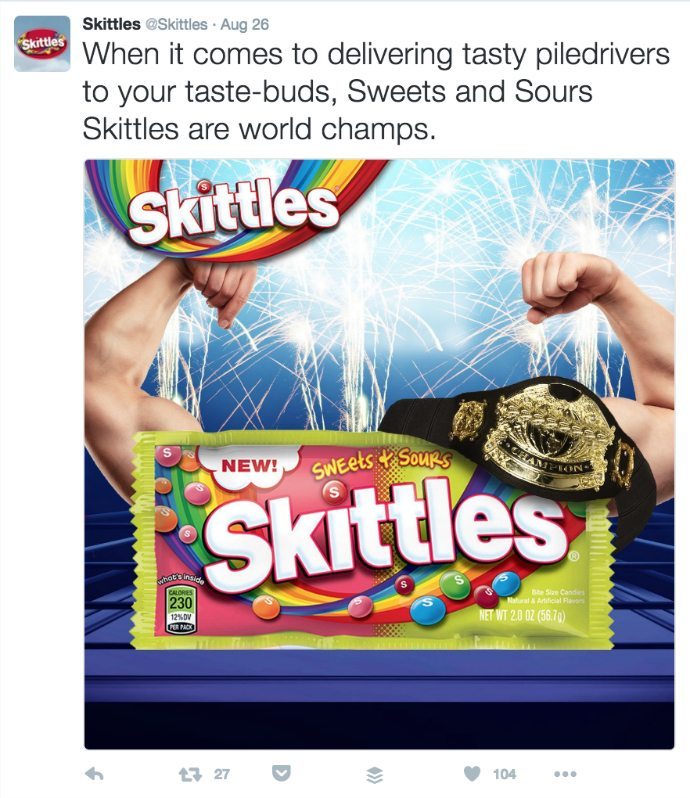 For reference:
For reference: 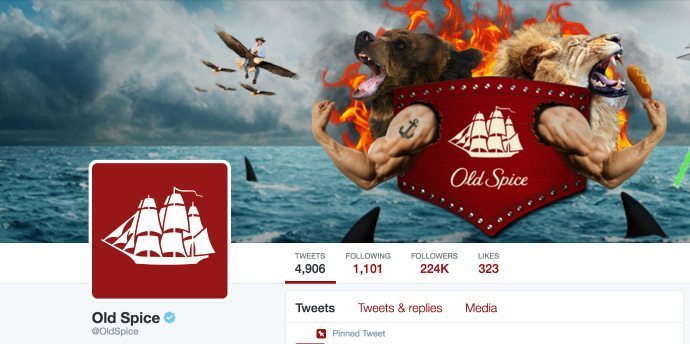 Imitating another brand will just turn your marketing efforts into an, um, arms race. And no one wants that. Please, please tweet me your favorite funny brands @punchlinecopy!
Imitating another brand will just turn your marketing efforts into an, um, arms race. And no one wants that. Please, please tweet me your favorite funny brands @punchlinecopy!












